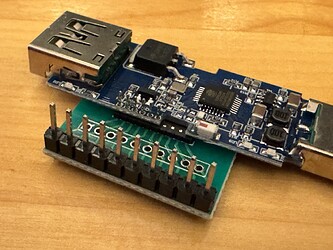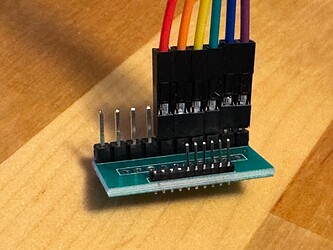This device allows you to turn the USB device connected to it on and off. It supports data pass through however my main uses are just to turn USB devices, such as a USB Microscope, on and off.
I found some very basic YAML online so I figured I’d create my own. Sharing in case others would like to use it. I split the YAML into two so that you don’t need to edit many files if you make changes to the core functionality in the template file.
While you can use the restore_mode to define the USB port state at boot up, I wanted to be able to configure it so I set it to ALWAYS_OFF and then switch it on if the configured default is On. If it isn’t, then it will switch it off at boot… this is not necessary unless you change the restore_mode to something that may default it to on.
The Red led is wired to the output mosfet that controls power to the USB port so it can’t be configured and will always turn on when the port is on. The green and blue leds are configurable however I let the blue led remain the status_led as I had no other function for it. The green led turns on when the port is off to indicate there is power, and off when the port is on and thus the red led is on. You can now also configure it to be on when the port is on (along with the red), or just disable it to minimize light output & power draw.
If you want to merge all the YAML into one file, remember to remove the extra indent on the YAML in the template file.
I am not a programmer so I am quite sure there are better ways to accomplish what I did… glad to get feedback on how to improve the YAML.
EDIT: For those who will likely tell me that I could have avoided lambda… I used it as it is more compact and IMO versatile. Boils down to personal preference.
microscope.yaml
substitutions:
devicename: microscope
devicename_no_dashes: microscope
friendly_devicename: "Microscope"
device_description: "Microscope"
update_interval_wifi: "120s"
restore_mode_setting: ALWAYS_OFF
#restore_mode: Control how the relay attempts to restore state on bootup.
#RESTORE_DEFAULT_OFF - Attempt to restore state and default to OFF if not possible to restore.
#RESTORE_DEFAULT_ON - Attempt to restore state and default to ON.
#RESTORE_INVERTED_DEFAULT_OFF - Attempt to restore state inverted from the previous state and default to OFF.
#RESTORE_INVERTED_DEFAULT_ON - Attempt to restore state inverted from the previous state and default to ON.
#ALWAYS_OFF - Always initialize the pin as OFF on bootup.
#ALWAYS_ON - Always initialize the pin as ON on bootup.
esphome:
name: "${devicename}"
friendly_name: "${friendly_devicename}"
comment: "${device_description}"
on_boot:
then:
- script.execute: on_boot_default_state
esp8266:
board: esp01_1m
framework:
version: recommended
restore_from_flash: true
wifi:
ssid: !secret iot_wifi_ssid
password: !secret iot_wifi_password
# Enable fallback hotspot (captive portal) in case wifi connection fails
ap:
ssid: "${devicename}"
password: !secret iot_wifi_password
ap_timeout: 3min
#Faster than DHCP. Also use if can't reach because of name change
manual_ip:
static_ip: 10.1.3.218
gateway: 10.1.2.1
subnet: 255.255.254.0
dns1: 10.1.0.50
dns2: 10.1.0.51
#Manually override what address to use to connect to the ESP.
#Defaults to auto-generated value. Example, if you have changed your
#static IP and want to flash OTA to the previously configured IP address.
use_address: 10.1.3.218
<<: !include template-usb-port-switch.yaml
usb-port-switch-template.yaml
logger:
logs:
sensor: INFO # DEBUG level with uart_target_output = overload!
binary_sensor: INFO
text_sensor: INFO
# Enable Home Assistant API
api:
ota:
- platform: esphome
password: !secret ota_password
web_server:
port: 80
version: 2
include_internal: true
ota: false
captive_portal:
# Sync time with Home Assistant
time:
- platform: homeassistant
id: ha_time
text_sensor:
- platform: wifi_info
ip_address:
name: "IP"
icon: "mdi:ip-outline"
update_interval: ${update_interval_wifi}
dns_address:
name: "DNS"
icon: "mdi:dns-outline"
update_interval: ${update_interval_wifi}
ssid:
name: "SSID"
icon: "mdi:wifi-settings"
update_interval: ${update_interval_wifi}
bssid:
name: "BSSID"
icon: "mdi:wifi-settings"
update_interval: ${update_interval_wifi}
mac_address:
name: "MAC"
icon: "mdi:network-outline"
scan_results:
name: "Wifi Scan"
icon: "mdi:wifi-refresh"
disabled_by_default: true
#Alternative, if blue led is needed for something else:
#https://esphome.io/components/light/status_led.html
status_led:
pin:
number: 16 # Blue LED
switch:
- platform: gpio
id: port_power
restore_mode: ${restore_mode_setting}
pin: 5
- platform: gpio
pin: 14
id: green_led
inverted: false
- platform: template
id: usb_port
name: ""
lambda: |-
if (id(port_power).state) {
return true;
} else {
return false;
}
turn_on_action:
- lambda: |-
id(port_power).turn_on();
turn_off_action:
- lambda: |-
id(port_power).turn_off();
on_turn_on:
- lambda: |-
if (id(green_led_mode).state != "Never" && id(green_led_mode).state != "Always") {
if (id(green_led_mode).state == "Port On") {
id(green_led).turn_on();
}
else {
id(green_led).turn_off();
}
}
on_turn_off:
- lambda: |-
if (id(green_led_mode).state != "Never" && id(green_led_mode).state != "Always") {
if (id(green_led_mode).state == "Port On") {
id(green_led).turn_off();
}
else {
id(green_led).turn_on();
}
}
binary_sensor:
#Status Binary Sensor exposes the node state (if it’s connected to via MQTT/native API) for Home Assistant.
- platform: status
name: "Connection Status"
id: connection_status
entity_category: diagnostic
# Button
- platform: gpio
id: btn
name: "Button"
pin:
number: 4
inverted: true
mode:
input: true
pullup: true
on_press:
- switch.toggle: port_power
sensor:
- platform: wifi_signal
name: "WiFi Signal"
update_interval: ${update_interval_wifi}
device_class: signal_strength
button:
- platform: restart
name: "Restart"
entity_category: diagnostic
- platform: safe_mode
name: "Safe Mode"
entity_category: diagnostic
select:
# option to control how LEDs are used. Red led is hardwaired to output so it cannot be controlled
- platform: template
name: "Green LED ON when"
icon: mdi:led-on
id: green_led_mode
optimistic: true
options:
- "Port On"
- "Port Off"
- "Always"
- "Never"
initial_option: "Port Off"
restore_value: true
entity_category: config
on_value:
- lambda: |-
if (id(green_led_mode).state == "Always") {
id(green_led).turn_on();
}
if (id(green_led_mode).state == "Never") {
id(green_led).turn_off();
}
if (id(green_led_mode).state == "Port On" && id(usb_port).state) {
id(green_led).turn_on();
}
if (id(green_led_mode).state == "Port On" && !id(usb_port).state) {
id(green_led).turn_off();
}
if (id(green_led_mode).state == "Port Off" && id(usb_port).state) {
id(green_led).turn_off();
}
if (id(green_led_mode).state == "Port Off" && !id(usb_port).state) {
id(green_led).turn_on();
}
# option to disable button
- platform: template
name: "Default Port State"
id: default_state
optimistic: true
options:
- "On"
- "Off"
initial_option: "On"
restore_value: true
entity_category: config
script:
- id: on_boot_default_state
then:
lambda: |-
if(id(default_state).state == "On") {
id(port_power).turn_on();
} else {
id(port_power).turn_off();
}
Edit: I added the platform under OTA so it works for ESPHome 2024.6+
Edit 19-DEC-2024: Updated code to make sure it is the latest.







